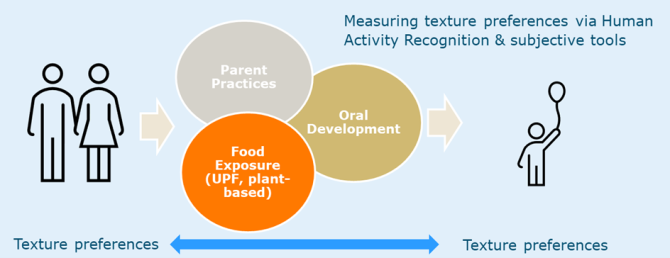
Project
Call for partners | TEXPLORATION: Steer texture preferences in children and parents to healthy and sustainable diets
The importance of food texture in healthy and sustainable diets has been increasingly acknowledged. The texture of foods is well known to play a significant role in acceptance or rejection of (healthy) foods, especially in children. Food products with appealing textures that are consumed fast are a risk factor for overconsumption and weight gain. To date, the transition to more plant-based protein sources affects our ‘textural’ diet with consequences for food acceptance. The first exposures to food textures start in infancy, and from there, eating behaviours are shaped and refined during childhood. Understanding textural preference development is needed to steer healthy and sustainable eating behaviours.
In recent years, the importance of food textures in modulating energy intake and metabolic responses has gained more attention, partly due to burning issues such as protein transitions and food ultra-processing. Food textures determine the oral processing and eating rate of foods and form a crucial factor in food acceptance and rejection. There are positive relationships between the rate of consumption (i.e., eating rate g/min) and weight gain in adults and children. Development of oral processing skills in childhood occurs in parallel with acceptance of more complex textured foods. In general, children develop preferences for textures that are ‘easily’ ingested as a function of their oral capacity. This evolves further as the child is more exposed to a wider set of food textures. Parents play a powerful role in the development of children's eating behaviour: they shape the eating environment for their children via parental practices and food availability. Providing a variety of healthy food textures, with supporting parental practices is essential to stimulate the transition towards healthier and sustainable diets within the family. There are knowledge gaps about how texture preferences develop over time, to what extent texture preferences of parents & children are related, and the modifiability of these texture preferences. Unique features of this project will be the development of a texture preference tool and the development of Human Activity Recognition (HAR, artificial intelligent tool) to measure textural preferences, food intake in children and parental feeding practices.
In TEXPLORATION, we aim to better understand how textural preferences develop in childhood and assess the roles of a) oral development capabilities, b) parental feeding practices, and c) food exposure (food textures offered). The ultimate outcome is to develop recommendations on promising strategies to support acceptance of textures of healthy and sustainable foods and to identify food characteristics that support this acceptance.

Partners
We are looking for partners from the food industry producing food products for children and/or families, child meal providers, AI technology, or ingredient suppliers interested in (child/toddler) foods, such as the fruit and vegetables sector, day care meal providers and producers of snacks or plant-based foods